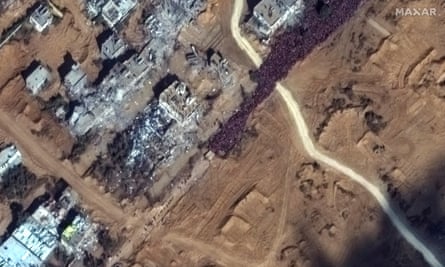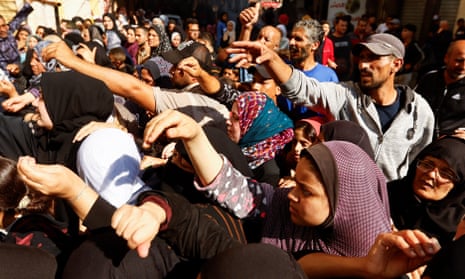The UN has said Gaza’s civilians face the “immediate possibility” of starvation, amid mounting concerns about Israeli plans to expand military operations in parts of the south where people have sought refuge from fighting.
Fuel shortages on Friday halted aid shipments and blacked out communications across the strip. The UN said its trucks could not move and it could not coordinate deliveries. Palestinian network operators said they could no longer power the phone and internet systems.
Fuel shortages have also in effect shut down water treatment and sewage systems, leading health authorities to warn about the spread of infectious diseases.
Israel said its forces were consolidating control of the north, as they continued the hunt for a Hamas command and control centre under al-Shifa hospital. A spokesperson attacked the “impatience” of demands for proof of Hamas headquarters there.
Since troops entered the compound on Wednesday, the military has published images of what it claimed was one tunnel entrance and weapons found in a truck inside the compound but no further evidence of Hamas activity.
Israeli authorities said Hamas fighters operated from beneath the wards, using patients and doctors as human shields, and held hostages there. The military on Friday identified a second hostage whose body was found near al-Shifa hospital as 19-year-old Cpl Noa Marciano.
Hamas denies operating from the hospital and on Friday said hostages found in the area had been taken for medical treatment, not held hostage at al-Shifa.
Israel released satellite maps and a computer animation that was claimed to detail Hamas networks and storage areas under the hospital. The US has said it has intelligence to support Israeli claims.
A spokesperson said entrances to Hamas tunnels would be well hidden and it could be a long operation to find them. “This could take time, it’s like finding a needle in a haystack finding that shaft,” spokesperson Lt Col Richard Hecht told journalists.
A doctor at the hospital said on Friday that Israeli forces had “found nothing” at al-Shifa, and that deliveries of food and water publicised by the Israeli military were “very minimal”, meeting the needs of less than half the medics, patients and refugees inside the complex.
“They have found nothing. They have found no single resistance. No single gunshot against them within the hospital area,” Dr Ahmed El Mokhallalati told Reuters by telephone. Despite the difficult conditions at the hospital, no babies had died there since Israeli troops entered it on Wednesday, he added.
The latest death toll from Israel’s military operations in Gaza is more than 12,000, 5,000 of them children, according to Hamas officials. A further 3,750 people have been reported missing, believed buried under rubble.
That official count includes all dead, and Israel said it had killed thousands of militants in nearly seven weeks of war. The conflict was triggered by a Hamas attack on Israel on 7 October that killed more than 1,200 people, most of them civilians.
Fears are growing for people crowded into the south of the Gaza Strip, as Israel’s military appears to be preparing to step up operations beyond northern areas that have been the focus until now.
Civilians in parts of south-east Gaza have been told in leaflets dropped by Israeli aircraft to move into a smaller “safe zone” in the coastal town of Mawasi, which covers just 14 sq km (5.4 sq miles), prompting warnings from the heads of 18 UN agencies and international aid groups.
“Without the right conditions, concentrating civilians in such zones in the context of active hostilities can raise the risk of attack and additional harm,” they said in a joint statement. “No ‘safe zone’ is truly safe when it is declared unilaterally or enforced by the presence of armed forces.”
Asked about the warnings to leave for the coast, Hecht declined to comment on planned military operations but said the situation “might remind you of how we started this in the north”.
There are already 1.6 million displaced people in Gaza, more than two-thirds of its population. Most fled the north after similar warnings that nowhere in or around Gaza City would be safe for civilians.
The exodus south has continued amid heavy fighting and even though almost anyone who leaves now must travel on foot. Satellite images on Friday showed a crowd hundreds strong apparently waiting to pass through a checkpoint on a road that Israel had declared safe for civilians.


The United Nations Office for the Coordination of Humanitarian Affairs said on Friday that more than 800,000 internally displaced people were staying in at least 154 shelters run by UNRWA, the UN Palestinian refugee agency.
The UN is not able to provide them with adequate food, water or medical care. Even when food has made it through, deliveries are “woefully inadequate” to tackle desperate hunger, with nearly all of Gaza’s 2.3 million people needing aid and the food infrastructure “no longer functional”.
Cindy McCain, the executive director of the UN World Food Programme, said: “Supplies of food and water are practically nonexistent in Gaza, and only a fraction of what is needed is arriving through the borders. Civilians are facing the immediate possibility of starvation.”
The World Health Organization said it was “extremely concerned about the spread of disease when the winter season arrives” with diarrhoea and respiratory infections rising faster than expected in crowded shelters.
Sewage treatment and water pumping plants have been shut down because of fuel shortages, and winter rains bringing the risk of floods could exacerbate problems.
Pedro Arrojo-Agudo, the UN special rapporteur on water and sanitation, called on Israel to allow water and fuel into Gaza to restart the water supply network.
“Every hour that passes with Israel preventing the provision of safe drinking water in the Gaza Strip, in brazen breach of international law, puts Gazans at risk of dying of thirst and diseases,” he said, according to Reuters.
Israel’s national security adviser said on Friday that a “minimal amount” of fuel would be allowed into Gaza for communications system and water and sewage services, and a military spokesperson said Israel would not limit UN shipments of humanitarian aid.
A broadening of military operations into the south raises concerns about where civilians could find shelter. Egypt has said it will not allow an exodus on to its territory and, despite Israel urging civilians to move south for their safety, Israeli attacks have continued there, though with less intensity than in the north.
A strike on a group of displaced people near the Rafah border crossing killed at least nine people, the Palestinian news agency Wafa and Al Jazeera TV reported.
Reuters and Associated Press contributed reporting
